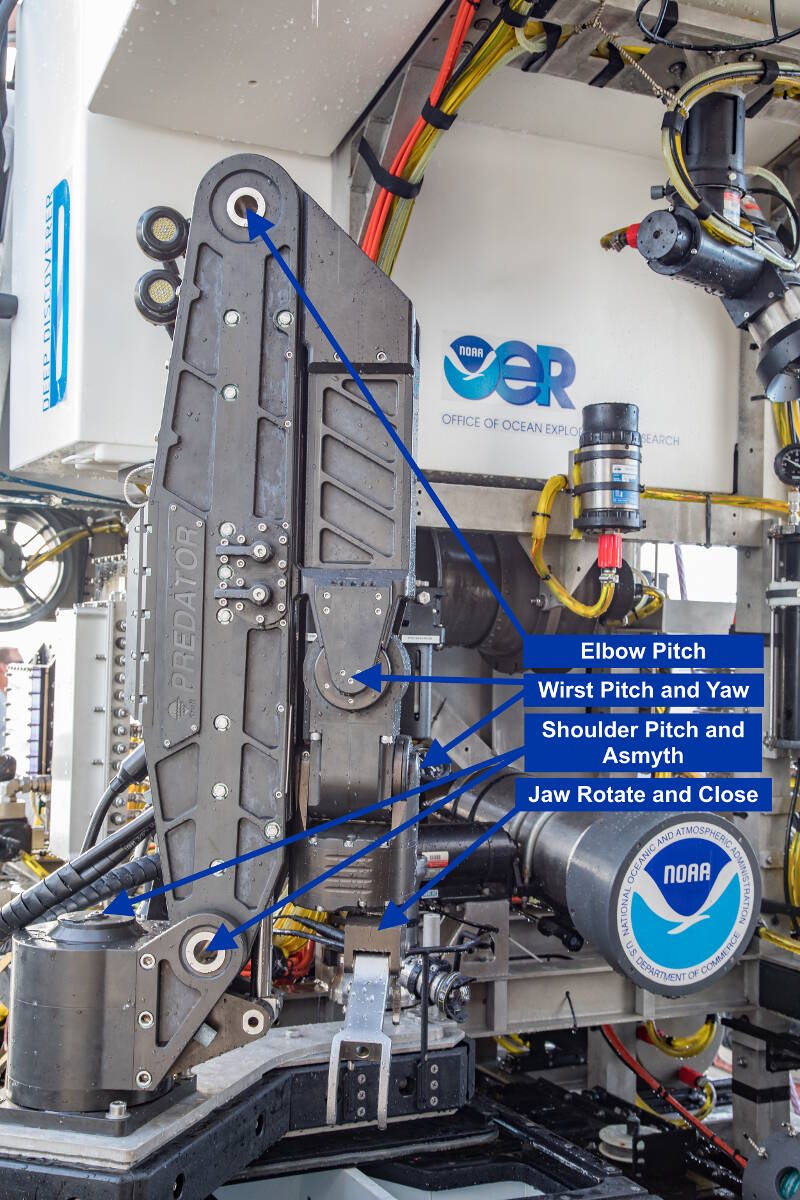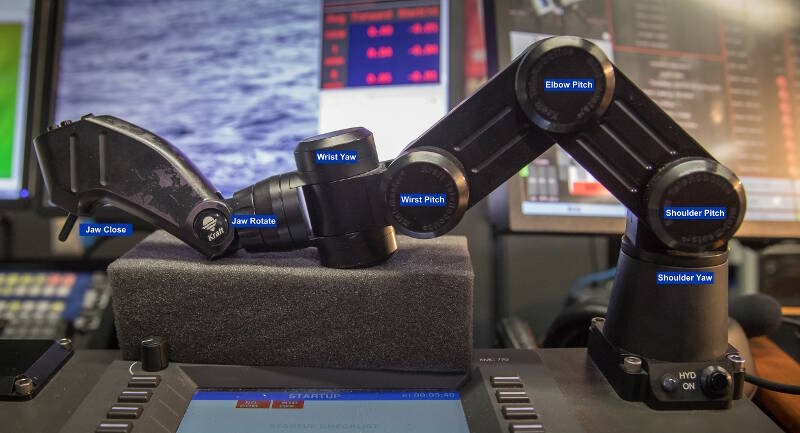
By Jeffery Laning - Global Foundation for Ocean Exploration
February 28, 2017

The quad screen view as Deep Discoverer uses the scoop tool to collect a mushroom coral. Image courtesy of the NOAA Office of Ocean Exploration and Research, 2017 American Samoa. Download larger version (jpg, 1.1 MB).
Hi, my name is Jeffrey Laning. I have been a remotely operated vehicle (ROV)/Electrical Engineer aboard NOAA Ship Okeanos Explorer since 2013.

Deep Discoverer's manipulator arm, labeled. Image courtesy of Art Howard, GFOE; edited by Jeffery Laning, GFOE. Download larger version (jpg, 5.4 MB).
If you watch the live video feed during dives, you will often see a large robotic arm emerge from the right side of the video feed, grab whatever is in the middle of the screen, and run away with it. This is a regular occurrence during our operations that we call “manipulator operations,” which is any time the ROV pilot uses the hydraulic manipulator mounted on Deep Discoverer (D2) to manipulate something on the bottom of the ocean. This can be anything from using a tool like our temperature probe or our sampling scoop to collecting samples directly with the jaws.
The part you don’t get to see is how the arm is controlled and the various difficulties that come with this process. You might not know it, but that arm is on the bottom of the ocean and the pilot is sitting in a control room on the ship up to 3.75 miles away. This has engineering difficulties that I won’t get into.
A difficulty pilots run into in using the arm to collect a sample is understanding the geometry of the arm, since it is not exactly the same as your own. Becoming acquainted with each of the arm’s seven joints, or functions, and knowing how to use them to put the jaws in position for a sample is not immediately intuitive for most people. To help operators, the manufacturer of the manipulator have included a few cool features that assist us as we use the arm.
First, to operate the arm, you move a scale model of the arm called the leader and the follower (the large subsea version) mimics those movements. This allows a pilot to simultaneously move many or all of the joints at once for smooth and efficient operations. The arm is also equipped with “force feedback”, which incorporates pressure sensors installed in the cylinders of the follower. When the arm is pressing against an object, that feedback is than transmitted to the leader in the control room and the pilot can “feel” that object.

ROV pilots use this scale model to control D2's manipulator arm when collecting a sample. Image courtesy of Art Howard, GFOE; edited by Jeffery Laning, GFOE. Download larger version (jpg, 2.1 MB).
Pilots must also overcome operating an object in three dimensions while viewing a two-dimensional video feed. As an example, you are able reach out for a glass of water because with your two eyes, you are able to determine depth in space called “depth perception”. Close one eye and this same task becomes harder. That is what a pilot is managing every time he is manipulating the arm. To compensate for this, multiple cameras are mounted on D2 from many different angles; it isn't the same as your eyes where depth perception is immediately achieved, as you have to consciously use two or three different cameras to understand where you are in each plane in space.
Operating the manipulator is a constant learning experience as shipboard scientists request us to collect many different types of samples and new tools are mounted on D2. This makes manipulation one of the most fun and exciting parts of piloting.